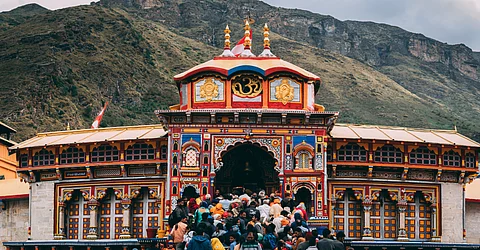
- Destinations
- Experiences
- Stay
- What's new
- Celebrating People
- Responsible Tourism
- CampaignsCampaigns
- Subscribe
- Buy Now

The Badrinath Temple, dedicated to Lord Vishnu, stands as a cherished pilgrimage site in India. It is an integral part of the revered 'Char Dham,' a group of four sacred locations deeply revered by Hindus. The temple's architectural marvel showcases a cone-shaped structure with a small cupola boasting a gilt bull and spire, leaving visitors awe-inspired. Though its origins are shrouded in Vedic legends, the prevalent belief attributes its establishment to Guru Adi Shankaracharya during the 9th century. As the pilgrimage season commences, the call to embark on a spiritual journey to this historical sanctuary grows stronger. Yet, amidst the grandeur of Badrinath lies a realm of lesser-known wonders awaiting discovery. Here's a look at them.
Tapt Kund
Located near the Badrinath shrine, Tapt Kund is a natural thermal spring believed to be the dwelling place of Lord Agni, the fire god. It is customary for devotees to bathe in this sacred hot water spring before visiting the temple. It is also believed that washing in the waters of Tapt Kund can cleanse devotees of their sins. Tapt Kund is also renowned for its medicinal properties, which are known to alleviate various types of skin allergies. The temperature of the kund averages around 55 degrees Celsius, while the surrounding temperature remains at a cooler 9-10 degrees Celsius.
Bheem Pul
Located at the confluence of the Saraswati and Alaknanda rivers, the Bheem Pul is a significant site near the Badrinath Temple. According to legend, during the Pandavas' journey to heaven in the Mahabharata, they reached a point where they needed to cross the Saraswati River. When Draupadi faced difficulty crossing the river, Bheema placed a large rock over the river to create a bridge. This rock is now known as the Bheem Pul and can be found in Mana village near Badrinath. Near the Bheem Pul is a shop that claims to be the last shop on this side of the Indian border.
Mana Village
Located just 3 km from Badrinath, Mana is Uttarakhand's first village at the Indo-Tibetan border. Elevated at about 3219 metres above sea level, the Bhotiya community inhabits the village, one of the most ancient tribes of Uttarakhand. Visitors can explore the charming rustic cottages and immerse themselves here. A visit to Vasundhara Falls, known for its cascading beauty, is a must-do activity. Witness the Saraswati River's origin and observe how it merges with the Alaknanda River, forming the Keshav Prayag.
Charan Paduka
Elevated at 3,380 feet above sea level, the Charan Paduka boulder holds religious significance. According to belief, the boulder bears the footprints of Lord Vishnu, imprinted when he descended from his celestial abode, Vaikunth, and set foot on Earth. Another tale mentions that Lord Krishna advised his minister Uddhav to visit Badrinath with his slippers (Charanpaduka), resulting in his footprints imprinting on the boulder. This incident is also mentioned in the Bhagwat Purana. The boulder is located approximately 3 km away from the Badrinath Temple and can be reached after a steep climb.
Narad Kund
Narad Kund is situated near the renowned Tapt Kund in Badrinath. It holds significant importance in the Badrinath pilgrimage. Before offering prayers at the Badrinath shrine, devotees often dip in this hot water spring. As per mythology, Adi Shankaracharya discovered the idol of Lord Vishnu here. Positioned on the left side of the Badrinath Temple, the kund receives its hot water from the spiritual rock known as Gauri Shila. The kund is named after Narad Muni, who is believed to have written the Narada Bhakti Sutra at this very spot. The hot water in the kund possesses medicinal properties that are said to be beneficial for treating various skin ailments.
Getting There
Tourists are required to trek to reach these off-beat locations in Badrinath. As for the holy shrine, it is well connected by all routes. If you travel via road, the nearest major town is Rishikesh, approximately 298 km away. The journey from Rishikesh to Badrinath takes around 10-12 hours. For those reaching by air, the nearest airport to Badrinath is the Jolly Grant Airport in Dehradun, approximately 317 km away. Hire a taxi or take a bus to reach the temple. If you are travelling via train, the nearest railway station to Badrinath is Rishikesh, which is well-connected to major cities in India.
Cover Photo Credit shiv.mer/Shutterstock.com
